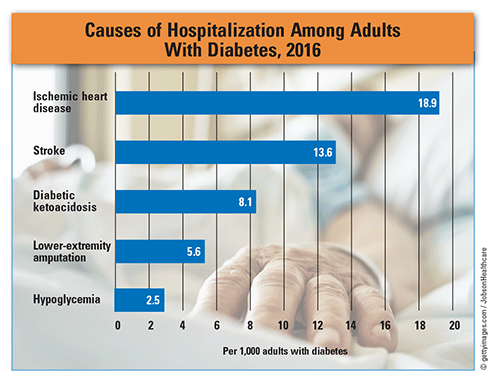US Pharm. 2021;46(11):14.
In 2016, 50% of U.S. adults had an A1C level of >7%, with 22.3%, 13.2%, and 14.6% having a level of 7% to 7.9%, 8% to 9%, and 9% or greater, respectively. Of adults aged 18 to 44 years, 16.3% had an A1C level of 10% or greater, compared with 12.7% of those aged 45 to 64 years and 4.3% of those aged 65 years or older. A non-HDL cholesterol level of 130 mg/dL or higher was present in 43.5% of diabetic adults. The 2020 National Diabetes Statistics Report noted that 7.8 million hospital discharges were recorded for 339 per 1,000 adults with diabetes.

Causes of Hospitalization: In diabetic adults, causes of hospitalization included cardiovascular disease, hyperglycemia, lower-extremity amputation, and hypoglycemia. For every 1,000 diabetic adults, ischemic heart disease was the cause of 40% more hospital admissions compared with stroke (18.9/1,000 vs. 13.6/1,000). The third major reason for hospitalization was diabetic ketoacidosis (DKA; 8.1/1,000), which caused 44.6% more admissions than lower-extremity amputation (5.6/1,000) and nine times more admissions than hyperosmolar hyperglycemic syndrome (0.9/1,000). Hospitalization for treatment of hypoglycemia (2.5/1,000) occurred in 30% of patients with DKA.
Risk Factors: Several factors increase the likelihood of diabetes-related complications, including overweight or obesity and smoking. That overweight and obesity increase the risk of diabetes-related complications is well known; however, 27.6%, 45.8%, and 15.5% of diabetic adults were overweight (BMI 25-29.9 kg/m2), obese (BMI 30-39.9 kg/m2) and morbidly obese (BMI >40 kg/m2), respectively. Among diabetic adults, 36.4% said that they had quit smoking cigarettes and 15% were still smoking; 21.6% reported using tobacco or had serum cotinine levels >10 ng/mL.
Preventive Actions: To reduce the risk of diabetes-related complications, the strategy most frequently employed by diabetic adults (36.4%) was to follow the standards of care for A1C, blood pressure (BP), cholesterol, and nonsmoking status. Of diabetic adults, 68.4% either had a systolic BP of 140 mmHg or higher or diastolic BP of 90 mmHg or higher or were taking prescription medication for hypertension. Additionally, 22.3% of diabetic adults adopted lifestyle changes to lose weight, including doing at least 90 minutes/week of leisure-time physical activity (15.8% of patients). Thirty-eight percent of diabetic adults were physically inactive (<10 minutes/week of moderate or vigorous activity) in the physical-activity categories of work, leisure time, and transportation. Just over 34% of diabetic adults had identified at least one source for continuous professional diabetes care. Among diabetic adults aged 40 to 75 years, 13.2% were on statin therapy—a small fraction (22.6%) of all adults (diabetics and nondiabetics) in that age group on statins.
The content contained in this article is for informational purposes only. The content is not intended to be a substitute for professional advice. Reliance on any information provided in this article is solely at your own risk.
To comment on this article, contact rdavidson@uspharmacist.com.





